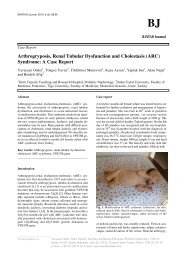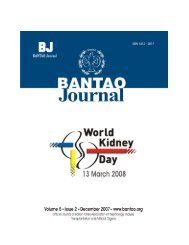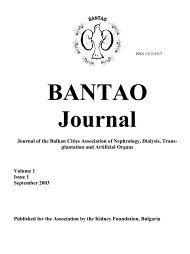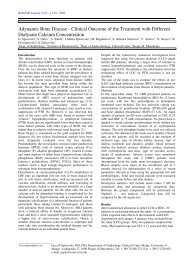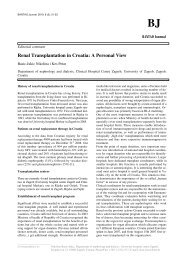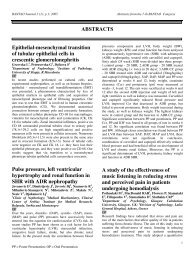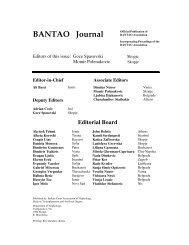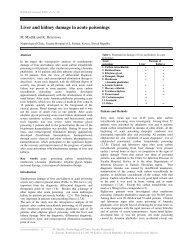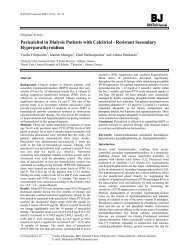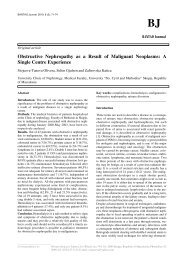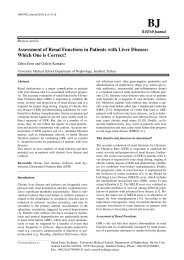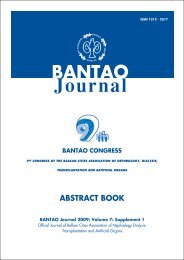Prospective Analysis of Factors Influencing the ... - BANTAO Journal
Prospective Analysis of Factors Influencing the ... - BANTAO Journal
Prospective Analysis of Factors Influencing the ... - BANTAO Journal
Create successful ePaper yourself
Turn your PDF publications into a flip-book with our unique Google optimized e-Paper software.
BJ<br />
<strong>BANTAO</strong> <strong>Journal</strong><br />
<strong>BANTAO</strong> <strong>Journal</strong> 2007; 5 (2) : 77–80<br />
Original Article<br />
<strong>Prospective</strong> <strong>Analysis</strong> <strong>of</strong> <strong>Factors</strong> <strong>Influencing</strong> <strong>the</strong> Antibody Response<br />
to Hepatitis B Vaccine in Hemodialysis Patients<br />
Alexandra Ouzouni, Elena Papadopoulou, Fotini Miari, Theodoros Pliakogiannis, S<strong>of</strong>ia Mademtzoglou,<br />
Kiriaki Traianou, Chrisovalantou Giannioti, Fani Papoulidou, Maria Kalientzidou<br />
and Kalaitzidis Kleonikos<br />
Department <strong>of</strong> Nephrology, General Hospital <strong>of</strong> Kavala, Greece<br />
Abstract<br />
Background. Patients on maintenance hemodialysis<br />
typically show a suboptimal immune response to hepatitis<br />
B (HB) virus vaccination compared to <strong>the</strong> non-uremic<br />
population. The aim or our study was <strong>the</strong> identification <strong>of</strong><br />
factors implicated in <strong>the</strong> vaccine response <strong>of</strong> our<br />
hemodialysis patients.<br />
Methods. We studied prospectively 63 hemodialysis<br />
patients who were seronegative for HB (37 males, 26<br />
females). Their mean age was 62.2±11.28 years (range 35-<br />
80) and hemodialysis. Duration 55.96±50.1 months (range<br />
6-225) fourteen <strong>of</strong> <strong>the</strong>m (22.2%) were diabetics. Our<br />
patients followed a four-dose vaccination schedule (0, 1, 2<br />
and 6 months) with 40 μg <strong>of</strong> a recombinant DNA HB<br />
vaccine. The antibody response was determined 1 month<br />
after <strong>the</strong> fourth dose <strong>of</strong> vaccination by assessing <strong>the</strong> titre <strong>of</strong><br />
antiHBs antibodies (ab). Immune response was defined as<br />
sufficient when <strong>the</strong> antiHBs ab level was ≥ 12 mIU/ml.<br />
During <strong>the</strong> 6-month vaccination period we also monitored<br />
monthly and time-averaged Kt/V, residual renal function<br />
(RRF), BMI, serum creatinine, albumin, transferrin, ferritin,<br />
CRP, iPTH and <strong>the</strong> dose <strong>of</strong> erythropoietin and Vitamin D<br />
that <strong>the</strong>y received.<br />
Results. An optimal immune response was achieved in 34<br />
patients (54%, responders) (antiHBs: 295.95±341.67<br />
mIU/ml), whereas 29 patients (46%, non-responders)<br />
showed a suboptimal response (antiHBs: 1.98±2.92<br />
mIU/ml) (p=1.75x10 -5 ). There was a statistically significant<br />
negative correlation between <strong>the</strong> antiHBs ab titre and BMI<br />
(r=-0.28, p=0.024). A significant difference was also found<br />
between <strong>the</strong> BMI <strong>of</strong> responders and non-responders as<br />
groups (24.8±5.5 vs. 27.2±4.5, p=0.02). Grouping our<br />
patients according to <strong>the</strong> existence <strong>of</strong> diabetes, age (cut <strong>of</strong>f<br />
60 years), and hemodialysis efficiency (Kt/V≥1.2) we<br />
found a statistically significant difference in <strong>the</strong> antiHBs ab<br />
titre between diabetics and non-diabetics (8.43±12.3 vs.<br />
200.2±317.7 mIU/ml, p=0.03), younger and older patients<br />
(262±365.09 vs. 84.36±189.1 mIU/ml, p=0.0145) and patients<br />
with efficient and inefficient hemodialysis (234.71±337.1 vs.<br />
79.14±200.99 mIU/ml, p=0.032). Treatment with vitamin D<br />
analogues, RRF and hypoalbuminemia were not found to be<br />
implicated in <strong>the</strong> immune response <strong>of</strong> our patients.<br />
______________________<br />
Correspodence to:<br />
Conclusions. It seems that increased BMI; diabetes;<br />
advanced age and inefficient hemodialysis impaired <strong>the</strong><br />
immune response to HBV vaccination <strong>of</strong> our hemodialysis<br />
population. Future studies should be conducted to<br />
investigate <strong>the</strong> need for tailored vaccination schedules for<br />
this hemodialysis subpopulations.<br />
Keywords: antibody response, hemodialysis patients,<br />
hepatitis B, vaccination.<br />
Introduction<br />
Patients on maintenance hemodialysis are at high risk <strong>of</strong><br />
infection with hepatitis B virus (HBV) despite segregation,<br />
universal precautions, vigorous vaccination protocols and<br />
<strong>the</strong> widespread use <strong>of</strong> erythropoetin leading to <strong>the</strong> reduced<br />
need for blood transfusions. At <strong>the</strong> same time hemodialysis<br />
patients typically show a suboptimal immune response to<br />
HB virus vaccination compared to <strong>the</strong> non-uremic population<br />
[1]. Protective antibody levels develop only in 60%<br />
<strong>of</strong> <strong>the</strong> hemodialysis population [2,3]. Many factors may be<br />
implicated in this suboptimal immune response such as<br />
uremia per se, altered renal metabolism <strong>of</strong> immunological<br />
active protein, <strong>the</strong> specific effect <strong>of</strong> renal replacement<br />
<strong>the</strong>rapy, malnutrition, chronic inflammation, inefficient<br />
dialysis, age, race, diabetes mellitus and many more [4-15].<br />
Moreover factors like insufficient vaccine dosing or omitting a<br />
dose may lead to suboptimal antibody production in<br />
hemodialysis patients [2-16]. In this context <strong>the</strong> aim or our<br />
study was <strong>the</strong> identification <strong>of</strong> factors implicated in <strong>the</strong> vaccine<br />
response <strong>of</strong> our hemodialysis population.<br />
Patients and methods<br />
From a cohort <strong>of</strong> 112 hemodialysis patients from our unit<br />
we studied prospectively 63 who were seronegative for HB<br />
(37 males, 26 females). An unsuccessful attempt for<br />
vaccination for HB was performed in 21 <strong>of</strong> <strong>the</strong> 63 patients<br />
included in <strong>the</strong> study. Positive patients for hepatitis B<br />
(HBeAg and anti-HBc) and those with a sufficient anti-HBs<br />
titer from former anti-HB vaccination, acute inflammatory<br />
status, malignancy and decompensated chronic liver disease<br />
were excluded. In addition, patients with autoimmune<br />
disease and patients which received immuno-suppressants<br />
Ouzouni Alexandra, Nephrology Department, General Hospital <strong>of</strong> Kavala, Amerikanikou Erythrou<br />
Staurou 113, 65001 Kavala, Greece; Tel.: 00302510292034; Fax: 00302510292034;<br />
E-mail: alouzouni@mail.gr
78 <strong>BANTAO</strong> <strong>Journal</strong> 2007; 5 (2)<br />
in <strong>the</strong> last three months were also excluded. The prevalence<br />
<strong>of</strong> hepatitis B and hepatitis C infection in unit is 2.67% (3<br />
patients) and 7,15% (8 patients) respectively. The<br />
demographic and laboratory characteristics <strong>of</strong> our study<br />
population are shown in Table 1.<br />
The laboratory values are <strong>the</strong> mean value <strong>of</strong> <strong>the</strong> six months<br />
observation period. The Mean age <strong>of</strong> our patients was<br />
62.2±11.28 years (range 35-80) and hemodialysis duration<br />
5.96±50.1 months (range 6-225). Fourteen (22.2%) <strong>of</strong> our<br />
patients were diabetics. Our patients followed a four-dose<br />
vaccination schedule with 40 μg <strong>of</strong> a recombinant DNA HB<br />
vaccine administered by deltoid intramuscular injection at<br />
time 0, 1, 2 and 6 months. We chose to use this vaccination<br />
schedule recommended by <strong>the</strong> U.S. Food and Drug<br />
Administration for Preventing Transmission <strong>of</strong> Infections<br />
Among Chronic Hemodialysis Patients because <strong>of</strong> <strong>the</strong> higher<br />
protective antibody response obtained (86%) in correlation<br />
with <strong>the</strong> three dose schedule (64%) recommended by <strong>the</strong><br />
European best practice Guidelines [17,18].<br />
Table 1. Demographic and laboratory characteristics <strong>of</strong> our<br />
hemodialysis patients<br />
Parameters<br />
Values<br />
Patients Number 63<br />
Males 37<br />
Females 26<br />
Male/Female ration 1.42<br />
Age (years) 62.2±11.28<br />
Time on HD* (months) 55.96±50.1<br />
Diabetics n=14 (22.2%)<br />
Time-averaged Kt/V 1.56±1.08<br />
RRF* (ml/min) 5.41±5.36<br />
BMI* (kg/m2) 26.03±4.13<br />
Serum creatinine (mg/dl) 9.53±2.48<br />
Serum albumin (g/L) 3.47±0.44<br />
Serum transferrin (g/L) 1.81±0.53<br />
Serum ferritin (mg/dl) 675.92±511.84<br />
CRP* (mg/dl) 1.05±1.41<br />
iPTH* (pg/ml) 187.21±171.31<br />
Erythropoietin dose (IU/week) 4790±3450<br />
* HD: hemodialysis, RRF: residual renal function, BMI:<br />
body mass index, CRP: C reactive protein, iPTH: intact<br />
parathormon<br />
The antibody response was determined 1 month after <strong>the</strong><br />
fourth dose <strong>of</strong> vaccination by assessing <strong>the</strong> titre <strong>of</strong> antiHBs<br />
antibodies (ab). AntiHBs titers were measured in plasma<br />
samples by enzyme immuneassay (Abbott Laboratories<br />
USA). The immune response was defined as sufficient<br />
when <strong>the</strong> antiHBs ab level was ≥12 mIU/ml. Those with<br />
levels 12-100 mIU/ml were termed “poor responders”,<br />
whereas those with levels >100 mIU/ml were termed “good<br />
responders”. During <strong>the</strong> 6-month vaccination period we<br />
also monitored monthly time-averaged Kt/V, residual renal<br />
function (RRF), BMI, serum creatinine, albumin,<br />
transferrin, ferritin, CRP, iPTH and <strong>the</strong> dose <strong>of</strong><br />
erythropoietin and Vitamin D that <strong>the</strong>y received.<br />
Statistical analysis<br />
Results are reported as mean ± SD. Statistical significance<br />
was calculated for differences between means by use <strong>of</strong> an<br />
unpaired t-test. Correlation between variables was<br />
performed by <strong>the</strong> Pearson correlation test. A P value <strong>of</strong> less<br />
than 0.05 was considered significant.<br />
Results<br />
An optimal immune response was achieved in 34 patients<br />
(54%, responders) (antiHBs: 295.95±341.67 mIU/ml),<br />
whereas 29 patients (46%, non-responders) showed a<br />
suboptimal response (antiHBs: 1.98±2.92 mIU/ml)<br />
(p=1.75x10-5). In <strong>the</strong> responder group 20 patients (59%)<br />
had an antibody titre <strong>of</strong> antiHBs > 100mIU/ml (good<br />
responders) and 14 patients (41%) had an antibody titre <strong>of</strong><br />
antiHBs 12-100mIU/ml (poor response). There was a<br />
statistically significant negative correlation between <strong>the</strong><br />
antiHBs ab titre and BMI (r=-0.28, p=0.024). A significant<br />
difference was also found between <strong>the</strong> BMI <strong>of</strong> responders<br />
and non-responders as groups (24.8±5.5 vs. 27.2±4.5,<br />
p=0.02). (Figure 1).<br />
BMI<br />
27,5<br />
27<br />
26,5<br />
26<br />
25,5<br />
25<br />
24,5<br />
24<br />
23,5<br />
24,8<br />
p 60 years 84.36<br />
Kt/V < 1.2 79.14<br />
Kt/V > 1.2 234.71<br />
responders<br />
nonresponders<br />
P<br />
0.03<br />
0.0135<br />
0.032
<strong>BANTAO</strong> <strong>Journal</strong> 2007; 5 (2) 79<br />
Discussion<br />
In our series, <strong>the</strong> percentage <strong>of</strong> patients responding to <strong>the</strong><br />
HB vaccine was 54% which is similar to <strong>the</strong> results<br />
obtained in o<strong>the</strong>r groups [2,3]. This percentage is lower<br />
than in <strong>the</strong> general population despite using a double<br />
vaccination dose, reflecting <strong>the</strong> immune deficiency <strong>of</strong><br />
patients with chronic renal failure. Many factors impinge on<br />
<strong>the</strong> effectiveness <strong>of</strong> a vaccine. Not only <strong>the</strong> potency <strong>of</strong> <strong>the</strong><br />
vaccine is important, but also patient characteristics. Along<br />
with uremia, malnutrition, obesity, diabetes mellitus,<br />
increased age, seropositivity for antibody against hepatitis<br />
C, impaired T-cell receptor expression and HLA DR3,<br />
DR7, DQ2 have been associated with poor response <strong>of</strong><br />
hemodialysis patients to HBV vaccine [2-12,14,15].<br />
Conversely, <strong>the</strong>re is evidence that Epo <strong>the</strong>rapy improves<br />
response rates [13]. But it is worth mentioning that <strong>the</strong>re is<br />
great controversy in <strong>the</strong> literature about <strong>the</strong> factors which<br />
are implicated in <strong>the</strong> antibody response <strong>of</strong> <strong>the</strong> hemodialysis<br />
population.<br />
In our study we found a better antibody response in <strong>the</strong><br />
group with lower BMI. In one study Chow KM et al found<br />
an inadequate anti HBs response in obese hemodialysis<br />
patients, which could in part be attributed to a low vaccine<br />
dose, so it could be assumed that obese patients are in need<br />
<strong>of</strong> an even higher vaccine dose or maybe <strong>the</strong> dose should be<br />
calculated according to body weight [2].<br />
We also found a better antibody response in <strong>the</strong> nondiabetic<br />
group, consistent with <strong>the</strong> findings <strong>of</strong> <strong>the</strong> previous<br />
study [2]. However ano<strong>the</strong>r study <strong>of</strong> Eardley et al did not<br />
confirm this finding in this paper <strong>the</strong> existence <strong>of</strong> diabetes<br />
mellitus did not affect response rates to <strong>the</strong> HB vaccine in<br />
hemodialysis patients [8]. We also found that patients in <strong>the</strong><br />
younger age-group had a better respond rate to <strong>the</strong><br />
vaccination schedule than our older patients, <strong>the</strong> same<br />
finding was also previously reported by o<strong>the</strong>r studies<br />
[2,5,9,12]. However o<strong>the</strong>r studies did not confirm an<br />
association between age and antibody response to <strong>the</strong> HB<br />
vaccine in HDpts [8,11]. Our study showed also a better<br />
immune response to vaccination in patients with higher<br />
Kt/V consistent with <strong>the</strong> findings <strong>of</strong> Kovacic V et al and<br />
Ibrahim S et al [10,11], a finding not confirmed by o<strong>the</strong>r<br />
studies [8,9,12].<br />
Despite <strong>the</strong> limitations <strong>of</strong> <strong>the</strong> present study, that is <strong>the</strong><br />
limited number <strong>of</strong> patients and <strong>the</strong> heterogeneous study<br />
population, as <strong>the</strong>re was an attempt for vaccination against<br />
HBV in some <strong>of</strong> our patients in <strong>the</strong> past, our findings are <strong>of</strong><br />
clinical relevance as some <strong>of</strong> <strong>the</strong> factors influencing <strong>the</strong><br />
antibody response could be modifiable. So maybe <strong>the</strong>re is need<br />
for a dose adjustment <strong>of</strong> <strong>the</strong> vaccine dose according to body<br />
weight in patients with a high BMI and diabetes mellitus.<br />
Ano<strong>the</strong>r option is to vaccinate our patients at an early stage <strong>of</strong><br />
chronic kidney disease before dialysis is started in an attempt<br />
to achieve a better antibody response at a younger age.<br />
Moreover optimizing <strong>the</strong> hemodialysis dose could also lead<br />
to a better immune response to <strong>the</strong> HB vaccination.<br />
Conclusions<br />
In conclusion, it seems that increased BMI; diabetes<br />
mellitus; advanced age and inefficient hemodialysis<br />
impaired <strong>the</strong> immune response to HBV vaccination <strong>of</strong> our<br />
haemodialysis population. However since <strong>the</strong>re is great<br />
controversy in <strong>the</strong> literature about <strong>the</strong> factors which are<br />
implicated in <strong>the</strong> antibody response <strong>of</strong> hemodialysis<br />
patients it seems that <strong>the</strong>re is need <strong>of</strong> a systemic review <strong>of</strong><br />
<strong>the</strong> literature and meta-analysis <strong>of</strong> clinical trials, moreover<br />
future studies should be conducted to investigate <strong>the</strong> need<br />
for tailored vaccination schedules for specific hemodialysis<br />
subpopulations.<br />
Conflict <strong>of</strong> interest statement. None declared<br />
References<br />
1. Schreiber GB, Busch MP, Kleinman SH, Korelitz JJ.<br />
The risk <strong>of</strong> transfusion transmitted viral infection. N<br />
Engl J Med 1996; 334: 1685-90.<br />
2. Chow KM, Law MC, Leung CB, Szeto CC, Li PK.<br />
Antibody response to hepatitis B vaccine in end stage<br />
renal disease patients. Nephron Clin Pract 2006;<br />
103(3): c89-93.<br />
3. Stevens CE, Alter HJ, Taylor PE, et al. Dialysis<br />
vaccine trial study group. Hepatitis B vaccine in<br />
dialysis receiving hemodialysis. Immunogenicity and<br />
efficacy. N Engl J Med 1984; 311: 496-501.<br />
4. Dumann H, Meuer S, Koehler H. Hepatitis B<br />
vaccination and interleukin 2 receptor expression in<br />
chronic renal failure. Kidney Int 1990; 38: 1164-68.<br />
5. Fabrizi F, Martin P, Dixit V, Bunnapradist S, Dulai G.<br />
The effect <strong>of</strong> age on immunological response to hepatitis<br />
B vaccine in end-stage renal disease. Meta analysis. Alim<br />
Pharm & Therap 2004; 20(10): 1053-1062.<br />
6. Fabrizi F, Dixit V, Dunnapradist S, Martin P. The<br />
dialysis mode and immunological response to hepatitis<br />
B virus vaccine in dialysis population. Meta-analysis.<br />
Alim Pharm & Therap 2006; 23(8): 1105-1112.<br />
7. Stachowski J, Pollok M, Barth C, Maciejewski J,<br />
Baldamus CA. Non-responsiveness to hepatitis B<br />
vaccination in hemodialysis patients: association with<br />
impaired TCR/CD3 antigen receptor expression regulating<br />
co-stimulatory processes in antigen presentation and<br />
recognition. Nephrol Dial Transplant 1994; 9: 144-152.<br />
8. Eardley KS, Jones H, Osman H, Smith S. Efficacy <strong>of</strong><br />
<strong>the</strong> accelerated hepatitis B vaccination schedule used<br />
in hemodialysis patients post-exposure to virus: a<br />
single-center experience. Nephrol. Dial Transplant<br />
2002; 17(11): 1982-1987.<br />
9. Peces R, de la Torre M, Alkazar R, Urra JM.<br />
<strong>Prospective</strong> analysis <strong>of</strong> <strong>the</strong> factors influencing antibody<br />
response to hepatitis B vaccine in hemodialysis<br />
patients. Am J Kidney Dis 1997; 29(2): 239-45.<br />
10. Kovacic V, Sain M, Vukman V. Efficient hemodialysis<br />
improves <strong>the</strong> response to hepatitis B virus<br />
vaccination. Intervirology 2002; 45(3): 172-6.<br />
11. Ibrahim S, el Din S, Bazzal I. Antibody level after<br />
hepatitis B vaccination in hemodialysis patients: impact<br />
<strong>of</strong> dialysis adequacy, chronic inflammation, local<br />
endemicity and nutritional status. J Nati Med Assoc 2006;<br />
98(12): 1953-7.<br />
12. Fernandez E, Betrin MA, Gomez R, Montolin J.<br />
Response to <strong>the</strong> hepatitis B virus vaccine in hemodialysis<br />
patients: influence <strong>of</strong> malnutrition and its<br />
importance as a risk factor for morbidity and mortality.<br />
Nephrol Dial Transplant 1996; 11: 1559-1563.
80 <strong>BANTAO</strong> <strong>Journal</strong> 2007; 5 (2)<br />
13. Hassan K, Shternberg L, Alhaj M et al. The effect <strong>of</strong><br />
erythropoietin <strong>the</strong>rapy and hemoglobin levels on <strong>the</strong><br />
immune response to Engerix B vaccination in chronic<br />
kidney disease. Ren Fail 2003; 25(3): 471-8.<br />
14. Girndt M, Sester U, Sester M, Kaul H, Koehler H.<br />
Impaired cellular immune function in patients with<br />
end-stage renal failure. Nephrol Dial Transpland<br />
1999; 14: 2807-2810.<br />
15. Kara IH, Yilmaz ME, Suner A, Kodiroglu AK,<br />
Isikoglu B. The evaluation <strong>of</strong> immune responses that<br />
occur after HBV infection and HBV vaccination in hemodialysis<br />
patients. Vaccine 2004; 22(29-30): 3963-7.<br />
16. Peces R, Laures AS. Persistence <strong>of</strong> immunologic<br />
memory in long-term hemodialysis patients and<br />
healthcare workers given hepatitis B vaccine: role <strong>of</strong><br />
booster dose on antibody response. Nephron 2001;<br />
89(2): 172-6.<br />
17. U. S. Food and Drug Administration. Recommendations<br />
for Preventing Transmission <strong>of</strong> infections<br />
Among Chronic Hemodialysis Patients. 2001; 50<br />
(RR05): 1-43.<br />
18. European best practice Guidelines. Section VI.<br />
Hemodialysis-associated infection. VI.6 Prevention<br />
and management <strong>of</strong> HBV, HCV and HIV in HD<br />
patients. Nephrol Dial Transplant 2002; 17: 78-81.



